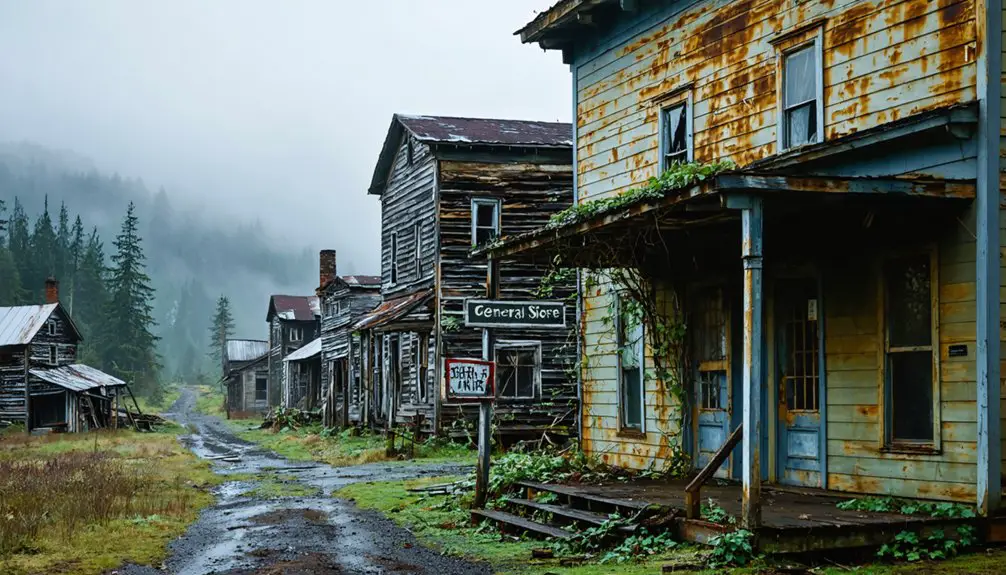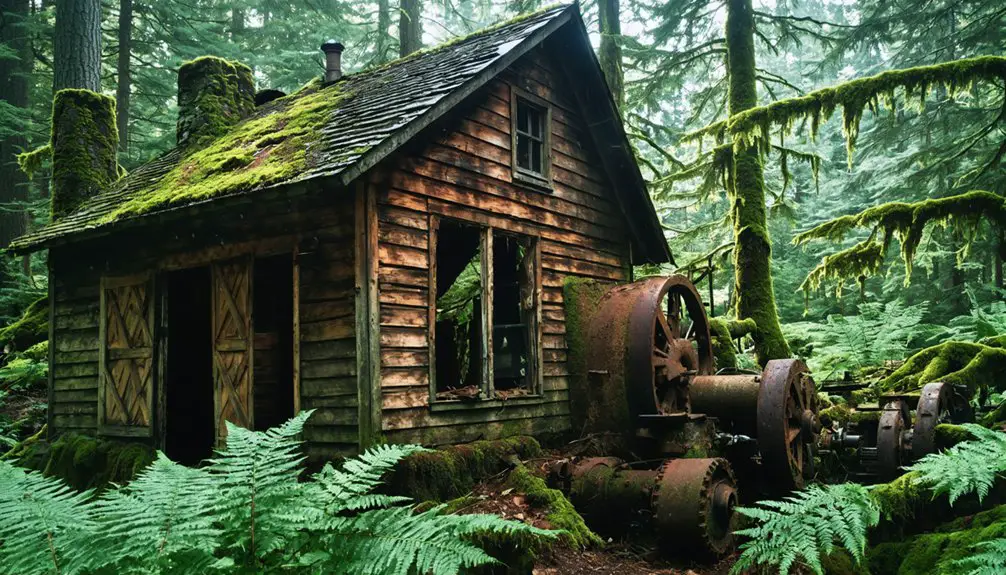You’ll find Maple Falls nestled near Mount Baker in Washington state, where crumbling lumber mills and empty storefronts mark what was once a thriving frontier outpost. The town boomed in the early 1900s through logging and mining, with the Chicago, Milwaukee, St. Paul and Pacific Railroad connecting it to major markets. Today, abandoned industrial remnants dot the landscape alongside natural attractions, while dark tales of notorious crimes add an eerie dimension to this atmospheric ghost town’s legacy.
Key Takeaways
- Maple Falls transformed from a bustling lumber town to a ghost town after the McGoldrick Lumber Company’s mill fire in 1945.
- Historic buildings, preserved sawmill ruins, and original post office sites remain as evidence of the town’s logging and railroad heritage.
- The decline began in the mid-1920s due to depleted virgin forests, disease affecting pine populations, and rising freight costs.
- Ghost town tours highlight the area’s dark history, including serial killers Frank Romandorf and William Frederick Jahns.
- Despite its ghost town status, Maple Falls attracts visitors with outdoor recreation, historic sites, and Silver Lake Park.
The Origins of a Mountain Frontier Town
The rugged mountains of northwestern Washington were home to the Nooksack people for over five millennia before Maple Falls emerged as a frontier settlement.
You’ll find their indigenous history deeply connected to the Nooksack River, where they built longhouses and seasonal camps, sustaining themselves through salmon fishing, hunting, and gathering. The Nootka Convention established early trading rights between Britain and Spain in the region.
Settlement patterns shifted dramatically in the 1850s when Euro-American pioneers pushed into these remote territories. The Donation Claims Act significantly accelerated settlement by granting land to pioneers arriving before December 1855.
You’ll discover how the establishment of the 49th parallel boundary in 1857-58 opened the door for newcomers seeking timber, stone, and mining opportunities.
The town’s distinctive name comes from a 35-foot waterfall on Maple Creek, where abundant maple trees lined the banks.
Boom Years: Lumber Mills and Gold Rush Dreams
While gold fever initially drew prospectors to Whatcom County, it was lumber that transformed Maple Falls into a thriving industrial hub by the early 1900s.
The town’s logging legacy grew alongside the Chicago, Milwaukee, St. Paul and Pacific Railroad, which connected remote timber operations to major markets. You’ll find evidence of both mining ventures and sawmills that once dominated the landscape, particularly along Boulder Creek where quarrying operations supplemented the timber trade. The adoption of sustainable-yield forestry helped ensure the long-term viability of local timber operations. The area’s earliest settlers, including the Nooksack tribe, maintained villages between Lynden and Maple Falls.
- By 1910, Washington’s timber industry employed 63% of the state’s wage workers
- Maple Falls’ post office name changed from Hardan in 1901, reflecting the area’s natural features
- Local mills relied on both private and public forestland for materials
- Mining and quarrying activities along Boulder Creek created a diverse resource economy
Decline of a Logging Empire
Following decades of intensive logging, Maple Falls began experiencing its first major industry decline in the mid-1920s as virgin forests throughout Northeast Washington became increasingly scarce.
The relentless appetite for timber left Maple Falls’ virgin forests depleted, marking the beginning of its industrial downfall by 1925.
You’d have witnessed the devastating effects of blister rust and root diseases on western white pine populations, forcing a shift to less profitable Ponderosa pine harvesting.
The Industrial Workers of the World, known as the Wobblies, organized protests to improve the harsh working conditions that plagued logging camps across the region.
The logging decline accelerated when McGoldrick Lumber Company’s mill burned in 1945, marking a turning point in the region’s industrial fate.
Rising freight costs, dwindling timber supplies, and operational challenges forced many mills to close.
Like the nearby Ames & Russell sawmill, many operations struggled with high transportation costs that cut deeply into profit margins.
While sustainable forestry practices emerged to combat resource depletion, they couldn’t prevent Maple Falls’ economic change.
The once-bustling logging town saw its population dwindle as workers sought opportunities elsewhere, leaving behind abandoned mills and camps that now stand as silent witnesses to a vanished logging empire.
Natural Wonders and Scenic Surroundings
Nestled within Mt. Baker Snoqualmie National Forest, Maple Falls rewards you with pristine natural wonders, from thundering waterfalls to scenic mountain vistas. The area features a 5-star rated Silver Lake Park that draws visitors year-round.
You’ll discover waterfall hikes ranging from the easily accessible Racehorse Falls to the more challenging Mazama Falls trail. Moderate hiking trails through fern-covered forests offer immersive nature experiences. Wildlife viewing opportunities abound, with the Nooksack River offering prime spots for observing majestic bald eagles in their natural habitat.
- Hard Scrabble Falls, Nooksack Falls, and Lower Wells Creek Falls create a trifecta of accessible water features
- Chain Lakes Loop Trail and Skyline Divide showcase panoramic wilderness views
- Silver Lake Park and Maple Creek Park provide peaceful spots for nature observation
- Mt. Baker Scenic Byway leads to Artist Point, offering spectacular mountain vistas
Tales From the Maple Falls Murder Farm
You’ll find chilling evidence of Frank Romandorf’s early 1900s murder spree at the Maple Falls Murder Farm, where he killed multiple victims including D.R. Shively and Agnes Jansen while operating under the alias James Logan.
Local police investigations uncovered grisly discoveries, including human remains in burning pyres and a trunk containing Shively’s body behind Romandorf’s house, leading to his eventual capture and 1911 execution. German-born Romandorf had a history of murders across countries, including similar crimes in Canada and South Africa.
The farm’s dark history continues to spark local legends, particularly after the 2017 discovery of human skulls by the Whatcom County Sheriff’s Office, though these were later identified as 1930s souvenirs unrelated to Romandorf’s crimes. The case gained renewed attention through a Bad Town podcast re-release examining the notorious murders.
Early Murder Cases
Among the darkest chapters in Maple Falls history, the early 1900s brought a series of brutal murders that would forever mark the town’s legacy.
In this isolated community, murder motives ranged from property theft to personal vendettas, while primitive forensic methods struggled to solve these heinous crimes.
You’ll find the most notorious case involved Frank Romandorf, who killed multiple victims and burned or buried their remains across local farms.
- Frederick L. Dames’s 1905 hatchet murder behind his meat market remains unsolved
- Agnes Jansen’s body was burned after Romandorf killed her for money in 1909
- D.R. Shively’s remains were found in a trunk behind Romandorf’s house
- Human skulls and bones discovered around Maple Falls farms revealed multiple victims
Local Police Investigation
When shots rang out on Green Valley Drive in February 2022, the sleepy town of Maple Falls witnessed one of its most serious modern police investigations.
Joel Young, an intoxicated 60-year-old resident, fired birdshot at two Whatcom County deputies responding to a neighbor dispute, striking both in the head.
The incident sparked a massive law enforcement response, with Bellingham SWAT and LEMART teams implementing enhanced police protocols.
You’ll find that the community’s role proved vital – neighbors provided first aid to the wounded deputies and assisted in securing the scene.
After Young’s surrender, investigators built a solid case focusing on his intoxication levels and the event timeline.
The resulting conviction brought a 40-year sentence, reinforcing community safety and marking a significant chapter in Maple Falls’ law enforcement history.
Murder Farm Legends
Deep within Whatcom County’s dark history lies the chilling tale of the Maple Falls Murder Farm, where German-born serial killer William Frederick Jahns, also known as Frank Romandorf or the “Maple Falls Monster,” committed a series of brutal murders in the early 1900s.
The murder farm folklore began when investigators discovered human remains, including two skulls and arm bones, on the property owned by Jahns under his assumed identity of James Logan.
- Jahns murdered his housekeeper Agnes Jansen, burning her body in a funeral pyre.
- He killed landowner D.R. Shively and buried him in a trunk behind the house.
- Local papers connected him to the unsolved 1905 murder of butcher Frederick Dames.
The serial killer history continues to fuel haunted tours, podcasts, and regional true-crime narratives.
Present-Day Remnants and Tourist Appeal

You’ll find tangible traces of Maple Falls’ past in its preserved sawmills and historic business district buildings, which stand as evidence to the town’s logging and railroad heritage.
The surrounding area offers year-round outdoor activities, from skiing at nearby Mount Baker to hiking, fishing, and whitewater paddling along the North Fork Nooksack River.
Boulder Creek’s popular camping grounds and the accessibility via Mt. Baker Highway make Maple Falls an attractive destination for both history enthusiasts and adventure seekers.
Visible Historical Sites Today
Today’s visitors to Maple Falls can explore numerous well-preserved structures from its early 20th-century heyday as a logging boomtown.
The town’s historical preservation efforts have maintained the architectural significance of Pacific Northwest logging town design, visible in the original business district‘s buildings and sawmill structures established by George Albert King in 1889.
- Original post office site and early settler cabins showcase the town’s founding era
- Historic sawmill machinery and foundations trace the once-thriving lumber industry
- Former railroad corridors and infrastructure reveal the town’s role as a rail logging hub
- Silver Lake Road, formerly Lake Street, preserves the original town layout with historic facades
Along the streets and paths once used by miners and loggers, you’ll find interpretive displays and artifacts that tell the story of this remarkable ghost town.
Recreation and Tourism Opportunities
While Maple Falls preserves its historical structures, the town and surrounding area offer rich recreational opportunities for modern visitors.
You’ll find year-round outdoor adventures at Mount Baker, where you can ski and snowboard in winter or hike and bike forest trails during summer months. The Mount Baker Highway provides scenic drives through Sprague Valley, connecting you to waterfalls and neighboring mountain communities.
Local shops like Marbled Arts showcase regional crafts and natural health products, while Silver Lake Park and Maple Creek Park invite you to boat, fish, or simply relax in nature’s embrace.
Whether you’re seeking solitude on mountain trails, photographing pristine waterfalls, or exploring unique local cuisine in nearby towns, Maple Falls combines its ghost town charm with abundant recreational possibilities.
Frequently Asked Questions
What Happened to George Albert King After Founding the Town?
You’ll find George King’s legacy lived on through his roles as constable, justice of peace, and treasurer. He invented machinery, sold land for a prison, and shaped Maple Falls’ impact until 1929.
Are There Any Descendants of Original Maple Falls Settlers Still Living There?
While local heritage events suggest community roots, you won’t find concrete proof of original settlers’ descendants living there today. Descendant stories exist in historical talks, but specific lineages remain undocumented.
What Specific Indigenous Tribes Inhabited the Maple Falls Area Before Settlement?
You’ll find the Nooksack Tribe was the primary indigenous group near Maple Falls, while the Lummi, Semiahmoo, and Samish tribes shared overlapping territories in the broader tribal history of native cultures.
Which Companies Operated the Major Sawmills During the Town’s Peak Years?
Like timber kings ruling the forest, you’d find Roeder & Peabody’s operations leading Maple Falls’ sawmill scene, while Weyerhaeuser Timber Company and numerous smaller local mills carved their slice of the timber industry’s prosperity.
Did the Railroad Tracks Remain After Service Ended, or Were They Removed?
In this area’s railroad history, tracks were removed after service ended, following regional patterns of track removal during the 1980s-1990s when rail shipping declined and companies merged.
References
- https://www.whatcomtalk.com/2020/06/05/the-ghost-towns-of-whatcom-forgotten-but-not-gone/
- https://www.whatcomtalk.com/2020/11/18/remembering-balfour-a-forgotten-whatcom-county-company-town/
- https://revisitwa.org/waypoint/maple-falls/
- https://bellinghistory.com/blog/2024/3/6/2y402h7xdndaxkmpdor7a776g8135i
- https://www.ghosttowns.com/states/wa/maplefalls.html
- https://www.historylink.org/file/1660
- http://admin.snowater.org/2004/earlyhistory.htm
- https://www.historylink.org/file/7327
- https://www.whatcomtalk.com/event/history-kendall-maple-falls/
- https://www.historylink.org/File/23155



